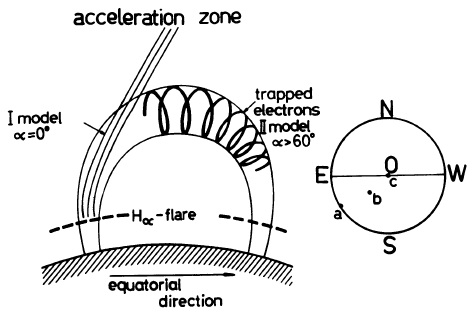
Tindo, I. P., V. D. Ivanov, B. Valníček, and M. A. Livshits, Preliminary Interpretation of the Polarization Measurements Performed on 'Intercosmos-4' during Three X-Ray Solar Flares, Sol. Phys., 27, 426-435 (1972) (ADS)

(click on the image for a larger version)
Date: 2011 January 20
Update: 2019 December 02
This cartoon illustrates the interpretation of the X-ray polarization signal expected from the thick-target beam model; it is a pioneering result from the Soviet space science program (Intercosmos-4 was one of the earlier space probes). The Tramiel cartoon illustrates the detector physics. There is a distinct lack of effort at polarization nowadays, perhaps because the limited observations available have not at all been encouraging, including the ones reported in this important early program. The polarization in this case would result from the directed motion of the electrons, but there would also be polarization present in the backscattered (albedo) photons with or without beaming. The location of the flare on the solar disk is important, because in the case of strictly (solar) radial electron motion, the projection of the polarization vector should lie along the line connecting flare and Sun center.
As a comment on the observability of linear polarization in a solar flare: an imaging polarimeter would be a huge improvement over Sun-as-a-star observations, given the complexity of the flare geometry.